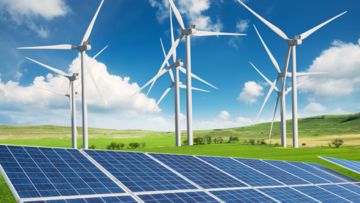Thematic Investing

Time to Rise to the Food Challenge
March 2023 | 4 minute read | Marketing Communication
The next time you're about to eat a forkful of your favorite food, it's worth pausing for a moment to think about all the elements involved in getting it onto your plate.
| "The way that we produce, process and package food is responsible for more than a third, or 34%, of humanly created greenhouse gas emissions – the cause of global warming – according to the UN."
|
"The food challenge is to find ways to keep feeding the world's inhabitants, particularly in rapidly developing economies, while at the same time doing so sustainably in order to help bring climate change under control."
|
"The answer lies in changing practices at every stage of the process; and, fortunately, helpful developments are coming rapidly."
|
Your food was probably initially grown, or reared, on a farm. Then it was transported, perhaps by train or truck, to be refined, cleaned, packaged and stored. Having traveled again as part of a delivery to your local shop or supermarket, it was then picked by you from the shelf and, finally, prepared as the meal you're about to enjoy.
In our highly diverse modern world, of course, that’s just one example. You might have ordered your food online, collected it from a fast-food outlet, or had it delivered as a meal-preparation kit. One thing that’s certain about food, however, is that our growing populations permanently need more of it. And producing it puts ever-increasing pressure on the planet’s natural resources.
Food Focus
Not only is food essential for our survival, but it is also at the heart of the battle to combat climate change.
The way that we produce, process and package food is responsible for more than a third, or 34%, of humanly created greenhouse gas emissions, according to the UN.1 Although farming and land use account for the majority of these emissions, the amount coming from the food-related supply chain, such as packaging and transport, for example, is increasing, the UN says.2
At the same time, the world’s populations are growing – by 2050, there are likely to be more than 9.7 billion hungry mouths to feed, according to the UN, up from 6.1 billion just 50 years earlier.3
And as societies become more sophisticated, consumers demand more choice, including out-of-season or exotic produce that has to be imported, increasing the risks of more pollution and additional waste.

Answering the Challenge
The food challenge, then, is to find ways to keep feeding the world’s inhabitants, particularly in rapidly developing economies, while at the same time doing so sustainably in order to help bring climate change under control (by eliminating emissions).
The answer lies in changing practices at every stage of the process; and, fortunately, helpful developments are coming rapidly. In farming, for example, there is precision agriculture, which uses sophisticated techniques such as drones and satellites to maximise production.
In agriculture and its supply chain, we are finding ways to use and reuse water more efficiently, including through irrigation and purifying technologies. And we are making greater use of recycled packaging while eliminating single-use plastics in wrapping.

The Big Push
One of our central benchmarks in the climate battle must be the UN’s 17 Sustainable Development Goals (SDGs) including, of particular relevance here, SDG 2: “to end hunger, achieve food security and improved nutrition and promote sustainable agriculture”.
By acting now we can make food make a difference, and help ensure that the better world of tomorrow comes more quickly. The time to think about food is today.
Sources
[1] UN Press release introducing Edgar Food database, March 2021 [2] UN Press release and study, November 2021 [3] UN, "The 2019 revision of world population prospects", 2019.
Important Information
Unless otherwise stated, all information contained in this document is from Amundi Asset Management S.A.S. and is as of March 2022. Diversification does not guarantee a profit or protect against a loss. The views expressed regarding market and economic trends are those of the author and not necessarily Amundi Asset Management S.A.S. and are subject to change at any time based on market and other conditions, and there can be no assurance that countries, markets or sectors will perform as expected. These views should not be relied upon as investment advice, a security recommendation, or as an indication of trading for any Amundi product. This material does not constitute an offer or solicitation to buy or sell any security, fund units or services. Investment involves risks, including market, political, liquidity and currency risks. Past performance is not a guarantee or indicative of future results.
Date of first use: March 2022
Doc ID: 2065323
You might be interested in

Renewable energy: power to conserve the earth
You’ve probably heard it called lots of different names: clean energy, green energy, sustainable or alternative energy. It’s most often and most clearly referred to as renewable energy; but what is it?

Video: Climate Action
Nobody can turn back time. But everyone can shape the future. Question consumer decisions, reduce your own CO2 footprint or invest sustainably.